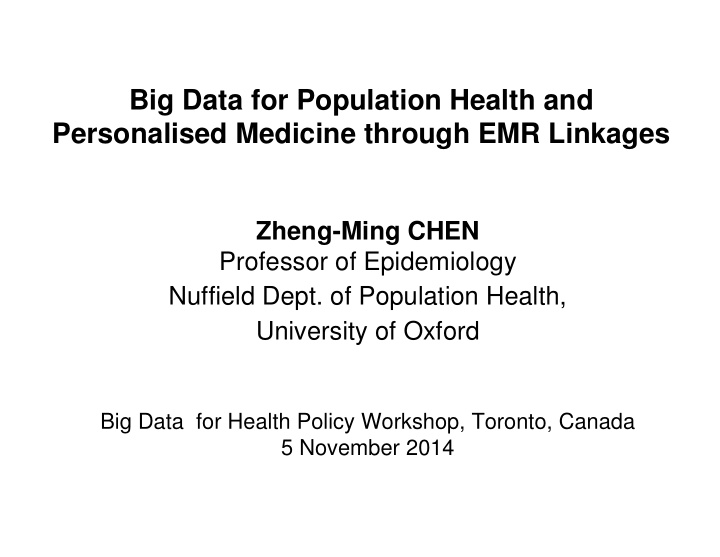



Big Data for Population Health and Personalised Medicine through EMR Linkages Zheng-Ming CHEN Professor of Epidemiology Nuffield Dept. of Population Health, University of Oxford Big Data for Health Policy Workshop, Toronto, Canada 5 November 2014
Declines in stroke mortality: not fully explained but nothing to do with genetic factors 2 2 Male Female Japan UK Annual deaths at 1 1 age 35-69 yrs per 1000 0 0 1950 1970 1990 2010 1950 1970 1990 2010 Year
China: large, unexplained mortality variations Oesophagus cancer Nasopharynx cancer Females only, hence little effect of tobacco or alcohol (Red = high mortality is >10x yellow = low mortality)
Age-specific trends in adult liver cancer and cirrhosis mortality in Qidong, China, 1980-2009
Trend of annual cigarette production in China (5% annual increase since 1998) ������������ 2000 billion ������������ 1000 billion 1949 1954 1959 1964 1969 1974 1979 1984 1989 1994 1999 2004
Cigarette consumption & lung cancer in US
CKB: Smoking patterns by year of birth among men Two thirds of men smoked, slightly higher in rural than in urban
CKB: Adjusted RR for total mortality by age started (Tobacco-attributed death: 25% urban, 15% rural) To be submitted to the Lancet, 2014
China Kadoorie Biobank: design (genetic & other causes of common disease) § 500K recruited from 10 localities in 2004-08 § Participants interviewed, measured, and gave 10 mL blood for long-term storage § Periodic resurvey of 5% (for regression dilution) § All followed up indefinitely via electronic record linkage to deaths and ALL hospital episodes General consent for access to health record for unspecified medical research
CKB: Location of the 10 survey sites in China (with different risk exposure and disease patterns) Harbin Qingdao Gansu Henan Suzhou Sichuan Zhejiang Hunan Urban Liuzhou Rural Haikou Chen Z, et al. Int J Epidemiol 2005, 2011
A human face on Mars? 1976: Viking Orbiter 2001: Mars Orbiter More observations allow a clearer, more precise, and more detailed picture of reality – also makes it less likely that we see patterns when none exist
SIZE matters: SBP vs IHD mortality, by age 5K, 50K & 500K randomly chosen from PSC* 5,000 adults 50,000 adults 500,000 adults Age Age Age 256 256 256 80-89 80-89 128 128 128 70-79 70-79 IHD mortality & 95% CI 60-69 64 64 64 80-89 60-69 50-59 32 32 32 70-79 50-59 60-69 16 16 16 40-49 8 8 8 50-59 40-49 4 4 4 40-49 2 2 2 1 1 1 120 140 160 180 120 140 160 180 120 140 160 180 Usual SBP (mmHg) Usual SBP (mmHg) Usual SBP (mmHg) * Prospective Studies Collaboration, Lancet 2002
CKB: Main data sources for linkage Death registries Outcome Disease Active follow- registries up Follow up in CKB Health insurance (national)
National Health Insurance system in China Health Care Information Management System Ischaemic stroke Confirmed by MRI By 1.1.2014, >98% of participants had been linked to the HI databases through unique national ID number
National health insurance system in China § Introduced during 2004-6 with almost universal coverage by 2010 § Diagnosis ICD-10 coded, plus disease descriptions and >2,000 procedure codes § Managed electronically at city or county levels, mainly for financial purposes (& itemised cost) In CKB ~1.6M episodes, ~20M procedures/tests, ~3500 diseases had been recorded during 2006-14
Strong political support within China
CKB: examples of new research using EMR § Infective causes of cancer ( WHO IARC, France) § Genetics to aid drug development ( GSK, Merck) § Multi-omics biomarker discovery (Oulu,SomaLogic) § Effects of air pollution ( Fudan University, China) § Healthcare delivery in China (Oxford & Fudan) Plus conventional epidemiological research
Drug Development Across the Industry: From Discovery to Approval • For 5-10,000 compounds discovered, only 1 becomes a FDA-approved drug • It takes 10-15 years to develop a new drug, costing ~US$1.3 billion • Despite soaring cost, the annual No. of approved drugs halved since 1996
Lp-PLA 2 § A phospholipase enzyme carried on LDL and macrophages in atherosclerotic plaques § Elevated activity predicts CVD risk, but causal effect uncertain § Null variants in PLA2G7F (found only in East Asians) , gene encoding Lp-PLA 2 , reduces enzyme activity § In animal models inhibitors of Lp-PLA 2 (darapladib) reduced coronary atherosclerosis § Two trials assessed the effects of darapladib in 30,000 patients CKB: using PheWAS approach to assess the efficacies and safeties of the inhibition of Lp-PLA 2 in 100K participants
CKB: Examples of PheWAS of genetic variant or GRS To compare disease risk between extreme thirds of a gene score based on all SNPs 0.5 1.0 1.5 Unpublished result s OR per allele (95% CI)
CKB: opportunities for multi- omics research Transcriptome Genome Metabolome Proteome Phenome ~40,000,000 ~20,000 ~100,000 ~5,000 ~5,000 We aim to genotype 510,000 samples using customised array
Genomics in medicine Understanding Understanding Understanding Advancing Improving the the structure of the biology of the biology of the science effectiveness genomes genomes diseases of medicine of healthcare DNA sequence Gene regulation Risk prediction Pathways Diagnosis Genes variation Gene function Targeted therapy Mechanisms Treatment Prevention ED Green et al. Nature 2011; 470 :204-213
CKB: Opportunities for BIG DATA using EMR and multi -omics information § Great increase in the range of diseases that can be studied § Improved power, disease classification & patient stratifications § Better understanding of genetic factors on multiple diseases with shared pathways/mechanisms § Further exploration of causative genes at loci discovered previously from trans-ethnic studies § Identification of novel biomarkers as therapeutic targets § Better predication of drug response and prognosis Need novel tools for data handling, analyses and interpretation
Oxford Big Data Institute
Recommend
More recommend